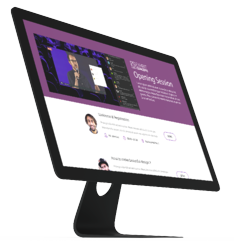There is a lot that goes into planning a virtual event. Maybe you are putting together a virtual event as a replacement for a canceled in-person event. Or perhaps, as an exhibitor, you feel you need to supplement what the show organizer is offering. In other cases, it may be that you’ve decided to put together your own virtual program to connect your salespeople with your target audience. Regardless of what is driving your plans, a best practice is to start with the end in mind and the return on investment (ROI) you hope to achieve.
One of the first decisions you will make with respect to a virtual event is when to host and for how long. A natural inclination is to plan your virtual event for the same time period as the in-person event would have been. But that may not be the best course of action.

There are three elements that are of paramount importance when planning your event. And thinking about them in relation to each other will help to determine key components of your plan such as the duration of your event. As you consider these together, if any one element is at an extreme, that is an indicator that you likely want to rethink how the virtual event should be executed:
- Goals and Outcomes,
- Leads (aka Attendees), and
- Effort
Goals and Outcomes
Most likely the purpose of your event is to work as a step in the sales and marketing process. Focus on what you are trying to accomplish and design your event around that singular focus. Check that your event is designed to maximize quality outcomes aligned to your goals. The last thing you want to do is expend a lot of resource (e.g. budget dollars, your time) and not generate any results.
Leads (aka Attendees)
Everyone who registers and/or attends your event has the potential to help achieve your goals. What is the best way to reach your intended audience and what effort is required to communicate your message? Can you reach a wide audience in a short amount of time? Or do you need more time perhaps spread out over several days with a more targeted audience?

Effort
Virtual events can be a ton of work. You might have new content to create and building an audience takes effort. What does the workload for you and your internal team look like to accomplish your goals? As with any sales or marketing effort, is the effort and energy in proportion to the outcomes? If not, it may be best to adjust the amount of effort to better align with attainable goals.
It is also incredibly important to remember that virtual events are not in-person events. It is possible to have fun, make connections and build an experience. But the fact of the matter is that people will never be as focused or as willing to commit their time to a virtual experience as they are to a face-to-face event. It is imperative to keep this in mind when looking at the length of time you are asking customers to commit to in order to hear your message. You only need to provide as much content as necessary to get the job done. If a 2-page focused document conveys all the necessary information a prospective buyer needs, why would you pump out a 50-page white paper? The same holds true for a virtual event. If a focused 2-hour event gets the job done, why would you ask attendees to join for three days of content?
So… how does this information help choose how long or what kind of an event you should plan? Let’s look at some examples:
| EVENT TYPE | GOALS/OUTCOMES | LEADS | EFFORT |
| 1 Day Event | By staying focused, single day events can have a nice clear track for outcomes. There is one commitment to attend and a focus on outcomes. | Target the right audience and ask attendees to make a simple commitment, e.g. 1 – 3 hours, and deliver desirable information and you should be able to meet your lead goals. | Medium effort – planning an event that pleases a wide audience is never an easy task but concentrating efforts to a single day creates a “specialness” to the event that can’t be missed. |
| 3 Day Event | A longer event provides more opportunity for high outcomes and more opportunity to connect with attendees and explain in detail what you offer. You can talk with someone on Day 1 and engage with them over the course of the event, accelerating them down the sales funnel. | If you focus on one audience, a 3 Day Virtual event is a significant commitment and unlikely they will stick with you through the duration. You may see engagement declines. However, you can provide more content tailor to different buyer personas.
If you focus on multiple audiences, this is more like several 1 Day Events |
High effort – even by potentially splitting your audiences into different tracks over 3 days, you and your team will be creating all that content at one time. |
| 1 Event/Week Over the Course of a Month | Because your content is spaced out, your outcomes may be as well. You are giving a huge time window for people to decide to engage. Consider strategies to keep your audience engaged and coming back each week. | If focused on one audience, you are asking for a significant commitment to attend multiple installments and you may see attendance drop off. However, this format works well for education and training and can bring attendees closer to your brand as they get to know you over time. | Medium/High effort – While spreading out your events may allow more time for content creation, very often you need to have almost all of the content ready at the beginning of the series so that early sessions can tease future content and help to maintain interest. |
Additional data to help in your event planning and deciding how to structure your event would be your historic “cost per” metrics and tolerances and expectations with digital tactics. What was your cost per lead with in-person events? Are you expecting the same/better/worse with your virtual event? The same goes for other metrics such as cost per follow-up/appointment and cost per sale.
The most important thing is to recognize that going to a virtual format does not necessarily mean that you are required to replicate the timing and duration of an in-person event. Quite the opposite. Focus on your goals and outcomes. What is the most effective way to deliver your message to drive those outcomes? What effort is required to achieve those results and is that level of effort worth the return?









